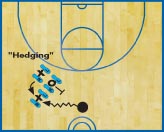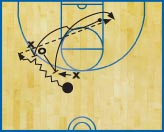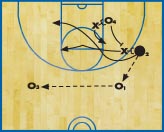Time-tested rules for defending screens
Most motion offenses today include a variety of picks (screens) to free the ball or players to the basket. These screens include on-the-ball screens, backscreens, cross-screens and downscreens.
The following are effective rules that you can instruct your players to follow for defending a variety of screens.
Rules for screens
RULE 1: Defending the ball handler during on-the-ball screens. If you are defending an opponent who has the ball and you are picked, try to fight over the top of the screen. Try not to get picked so that you can easily switch. Feel and “see” with your hands, and anticipate or sense the picks coming. Listen for verbal warnings from your teammates.RULE 2: Fighting through screens. When you get picked, try to get a foot and ankle in the gap, then a leg and hip, and finally the rest of your body over the top of the pick by arching your back and squeezing through. Once you’re through the screen, play tough defense. Keep your hands up to prevent the shot, or pass over the top to the individual who is rolling or releasing to the basket.
RULE 3: Defending the screener during on-the-ball screens. If you’re defending the screener on the ball, stack your feet in line with the screener’s feet until the dribbler approaches (see Diagram 1).
As the dribbler approaches, move out so that your inside foot is directly to the side of the screener’s outside foot with your inside hand on the screener’s outside hip. Once this position is established, jump out in the path of the dribbler to:
- Draw a charging foul or another turnover.
- Force the ball handler to pick up the dribble.
- Make the dribbler bow out away from the basket and screener. This defensive technique is called “hedging.”

DIAGRAM 1: Hedging. This diagram shows defenders how to position their feet while hedging.
RULE 4: Effectively switching on screens. The defensive player who is guarding the screener should yell “screen!” And if he or she sees that the teammate can’t get through the screen, he or she should yell “switch!” Both defenders should switch without question or hesitation.
RULE 5: Defending the pick-and-roll. If there’s no switch, the defensive player who’s defending the roller should treat the pick-and-roll player as a backdoor cutter. That is, the defender should face him or her as he or she rolls until that player cuts through the free-throw lane. At that point, the defender opens up to the ball.

DIAGRAM 2: Defending the pick-and-roll. Your team should have help-side defense for any players who are cutting to the basket.
RULE 6: Defending backscreens. When you get backscreened, go on the ball side of the pick, fight around it, and face your assigned opponent (who is backcutting) until he or she starts across the free-throw lane — which is when you should open up to the ball.
Sagging off in the “ball-you-man” principle makes it difficult for the offense to execute. As soon as your assigned opponent passes the ball, jump off your opponent and to the ball.

If you get backscreened, fight through the ball side of the screen and treat the cutter as if he or she is a backdoor cutter. Do not switch on backscreens, but the player who is defending the screener must warn his or her teammate of the oncoming backscreen.
DIAGRAM 3: Defending the backscreen. This diagram shows the movements for defending backscreens on any ball reversal on top.
RULE 7: Defending downscreens. Fight hard and quick on the ball side of the pick to be in the passing lane at the top of the downscreen, just in case the outer offensive player runs a “curl.” Anticipate the backdoor cut, and treat it the same as you would for any other backdoor cut (DIAGRAM 4).

The defender guarding the screener should give his or her teammate room to get through on the downscreen. Communication is a key element for defending any type of screen. Always go on the ball side, and fully extend the arm on the side that’s closest to the ball.









